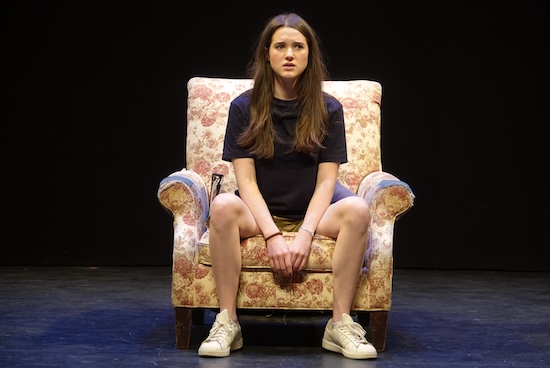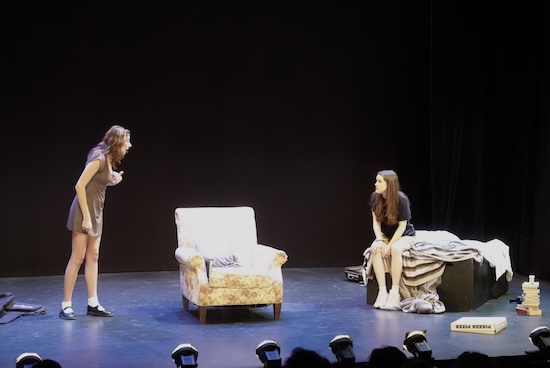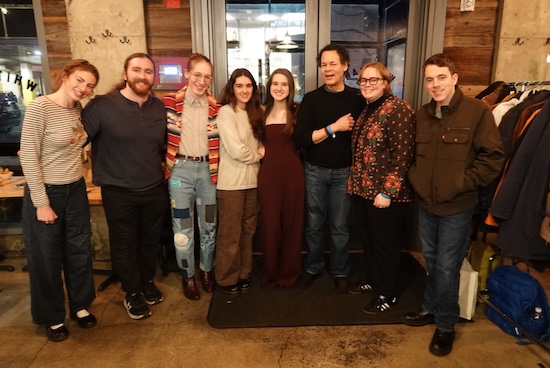
c/o Keira Moran
This article mentions depictions of suicide in a theater production.
Last weekend I had the pleasure of seeing “LIKEWISE,” a play that debuted at the University in Spring 2024. Kiera Moran ’24, who wrote and performed the show as a senior thesis in partial fulfillment for honors in theater, reprised her role as Joey, a troubled teenager who calls a suicide hotline to order a pizza, as part of the New York Theater Festival.
Moran submitted her play to the festival and received confirmation of its acceptance only 13 days after “LIKEWISE” concluded its original run. This kicked off a year-long process of preparation and perseverance through unexpected delays, before the play finally took the stage at The Hudson Guild Theatre on Jan. 27, Jan. 31, and Feb. 2.
Moran explained that she and director Bannon Brody ’24 opted to bring the original cast back for the festival, hoping to further the character development work they started in the original run of the show.
“Diving into everyone’s motivation and backstory was something the actors contributed to so generously,” Moran said.
Moran also noted that April Schwartz ’24, who played Joey’s therapist, helped rewrite some of her own lines to ensure authenticity in representing the character’s experience of being transgender.
“It would have been like starting from scratch in some ways if we had to bring in anyone else,” Moran added.
With the cast scattered geographically, the team primarily rehearsed over Zoom. Despite the challenge of remote rehearsals, Brody noted that the cast and crew’s familiarity with the production made the process easier.
“The timing of movements, sound [and] light cues—all of that was already established,” Brody said.
Having these structures in place allowed Moran to become more comfortable in her acting role, even as she spent most of the 80-minute run of the show on stage. In addition to the virtual rehearsal process, the production team worked through a condensed tech schedule. Stage manager Maddie Morehead ’24 and sound and lighting designer Alex White ’26 completed the full cue-to-cue (a run-through of the entire show from one technical cue to the next) right before the show took place. This is a process that typically takes place over multiple days. Under the time pressure, Morehead and White finished in under four hours.
The New York production saw several changes from the original version, both in staging and storytelling. Marketing also proved different in New York. Moran emphasized the challenge of drawing an audience in a city overflowing with entertainment options.
“At Wesleyan, theater is one of four things to do on a Saturday night,” Moran joked. “In New York City, it’s one of 10,000.”

c/o Keira Moran
Brody highlighted that the shift of the show’s potential audience also affected the new production.
“At Wesleyan, we had an innate sense of who we were doing this play for,” Bannon said. “In New York, we didn’t know who was going to be showing up. We had to recreate that context within the story for people outside of our generation.”
Several key moments in the play were altered or refined for the New York run. Compton Stewart ’24, who voiced Jake, adjusted his portrayal to obscure his true intentions from the audience at first, making his character’s actions throughout the play more shocking and dramatic.
“Joey actually doesn’t know that Jake is creepy at the beginning, which makes for a more compelling narrative,” Moran explained. “Moments that didn’t hit the first time, we played differently the second time.”
The play’s opening also underwent a major transformation.
“In the Wesleyan run, I would play ‘Somebody’s Watching Me’ and I would dance onto [the] stage,” Moran said. “The second time, we took that opening moment more seriously. I was already on stage, completely still, as the audience filed in.”
Walking into the show and seeing Moran on stage immediately immersed the audience in Joey’s world. The change made what came next, Joey calling the suicide hotline, less jarring because we already knew a bit about whom this girl was. Similarly, this choice created a foundation for the “Fleabag”-esque connection that the audience has with Joey throughout the show, which was present in the initial run but stronger in New York because of new creative choices. Rewrites focused on audience reception from the first run.
“What parts of the story did people pick up on?” Moran recalled asking herself during the revision process. “What did most people not mention? What do I want people to think more about?”
One major rewrite involved Joey’s stand-up monologue. Originally self-deprecating and comedic, it was rewritten to emphasize its emotional core.
“The moment isn’t about Joey—it’s about Callie [Paige Merril ’26],” Moran said. “[Joey] is confronting her fear that she is difficult to love. Placing her in a comedic context and then stripping that away to force her to speak the truth made for a stronger climax.”
Similarly, the second-to-last scene—where Joey returns home to find her mother asleep on the couch—shifted focus between the two runs.

c/o Keira Moran
“Originally, it was more about Joey’s experience,” Moran said. “The rewrites made it more about how she sees others. It was meant to convey her growth—how she moves from being inwardly focused to recognizing her impact on others.”
The show’s trajectory demonstrates Moran and her team’s ability to adapt and succeed outside of the University’s creative space. They persevered through the challenges of creating art in a professional setting and adapted their show to better communicate the feeling of the show to a wider audience.
Among their various other jobs, Moran and Brody both plan to continue to work in the arts. Moran is working on writing her next play, and Brody is making a web series called “Regression.” The first episode is out, and the second is on its way.
Emma Nielsen can be reached at enielsen@wesleyan.edu.